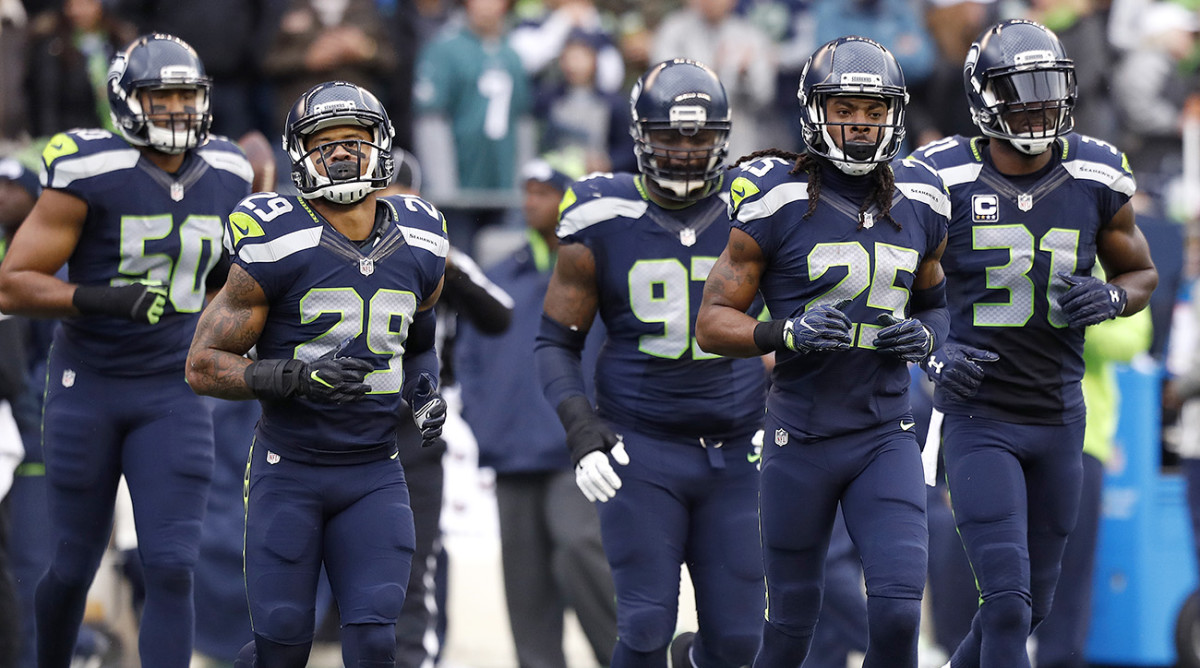Seattle Seahawks: 10 Things You Need to Know

1. Russell Wilson is difficult to analyze. He doesn’t always play on time in the pocket, which leads to missed opportunities and broken-down plays. But in those broken-down plays, Wilson can also conjure other plays that would never exist for most passers. He’s a great touch thrower, particularly on the move, including when he’s moving left. That said, it’s hard to be a consistent with a sandlot style quarterback, and indeed the Seahawks have always been a week-to-week offense. To curtail this, they’ve emphasized spread formations that demand Wilson get the ball out almost immediately after the snap. Wilson, to his immense credit, has responded well. He’ll never be a classic dropback passer, but in the last year and a half, he’s a much-improved quick pocket passer.
2. When you get the ball out quickly after the snap, it’s imperative that you identify the coverage before the snap. Moving tight end Jimmy Graham around the formation helps with that. It’s how Graham should be used anyway. He’s too scary of an athlete to just plug in as a static line-of-scrimmage tight end.
3. Another Seahawk who has improved his game is Doug Baldwin. His route tree has expanded beyond the slot patterns that once defined him. And when Baldwin is in the slot, the Seahawks do a great job of getting him open through pick routes and deep-over routes, where he can cross the field and attack zone linebackers and safeties.
Bobby Wagner Can See into the Future
4. Everything you hear about Seattle’s putrid offensive line is true. Last season the front five struggled mightily against athletic D-lines—a real problem when you share a division with the Rams and Cardinals. That’s why GM John Schneider spent a second-round pick on Ethan Pocic, one year after drafting Germain Ifedi and Rees Odhiambo in the first and third rounds. Expect musical chairs up front through the first part of the season. The one sure thing is center Justin Britt. He’s a plus-athlete who has developed a good feel for locating blocks in short areas and working up to the linebacker level.
5. Ultimately, the running back rotation should feature Thomas Rawls at the front, versatile 2016 third-rounder C.J. Prosise on third downs and the subtly light-footed Alex Collins in a backup role. It’s hard to see where Eddie Lacy, a plodding but insistent runner, fits in. However, that was true in Green Bay, too, and Lacy was often productive. He has no dynamic traits, but he can turn two-yard runs into three-yard runs. Maybe that gets valued more in Seattle given the questions along the O-line.
6. This defense has changed under coordinator Kris Richard. It is no longer just a straight Cover 3 zone unit. Richard is a big believer in man coverage. He often blitzes out of it (linebacker Bobby Wagner is the fifth rusher). He’ll have Richard Sherman travel with top receivers. And he plays Earl Thomas all over, not just in centerfield. It’s a fundamentally different Seahawks defense than what we saw under Dan Quinn and Gus Bradley.
Richard Sherman Trade Talk: ‘There Is No Bad Blood’
7. I owe Richard Sherman an apology. I ranked him as the No. 16 cornerback in my MMQB 400 earlier this summer. I was concerned about Sherman’s susceptibility to in-breaking routes. But after reading all 18 games of my Seahawks film notes to write this piece, I see now that I fixated too much on this. Sherman, with his long and angular body, has naturally always struggled against in-breakers. Last season, which wasn’t his best, those struggles were a little more pronounced. But they didn’t define him. He’s still an excellent boundary corner, especially against vertical routes, and what always stands out on film but goes unnoticed elsewhere is his fervidity in run support. Sherman is still a top 10 corner—I got that one wrong.

8. There isn’t a better safety duo than Earl Thomas and Kam Chancellor. In the seven games in which they both played last season, the Seahawks allowed 14.3 points and 217.3 passing yards an outing. In the games that one of them missed, Seattle allowed 21.3 points and 264.2 passing yards. The Seahawks’ Cover 3, which has been reduced in frequency but is still the defense’s foundation, works because of them. Thomas has the centerfield range to cheat his coverages. Chancellor has the downhill thumping ability to play a little deeper than a typical strong safety, which makes Seattle harder to throw against.
9. If healthy (he suffered a wrist injury in practice on Monday), defensive lineman Frank Clark will be a superstar by season’s end. His initial quickness, change-of-direction agility and closing burst are just too dynamic. Clark, who plays inside and outside, is an excellent fit along a Seahawks front four that makes great use of stunts and twists in obvious passing situations.
10. Besides being superb run defenders, Bobby Wagner and K.J. Wright are reliable in coverage—a rarity for Cover 3 inside linebackers. When offenses use trips-receivers formations (which more and more are doing now), the inside linebacker often gets matched against the furthest inside wide receiver. That’s a problem for most defenses, but Wagner and Wright both have the speed and awareness to survive in those scenarios.
• Question or comment? Email us at talkback@themmqb.com.
